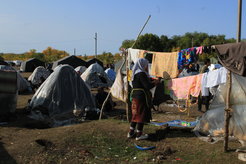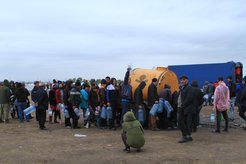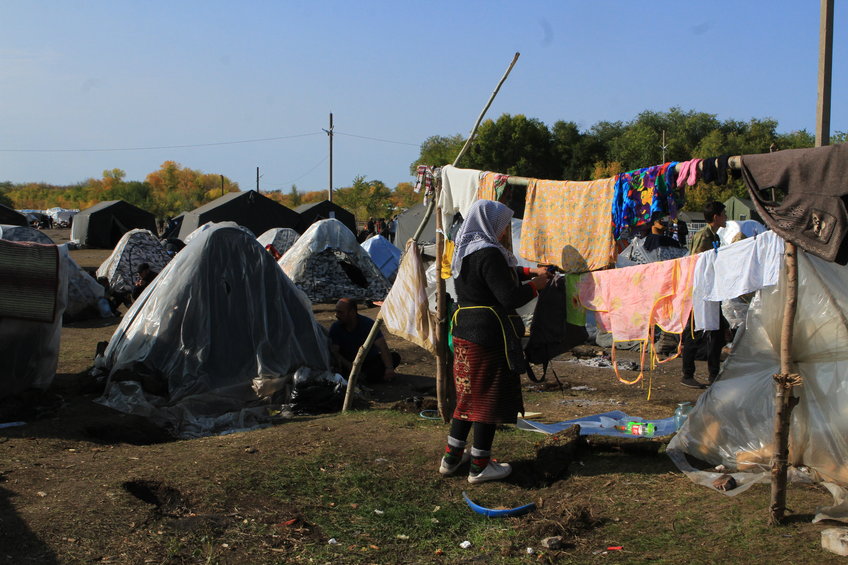
Camps on the border: Central Asian migrant workers at the Russian-Kazakh border during the COVID-19 pandemic
Nurlan Muminov
Muminov, Nurlan. 2021. Camps on the border Central Asian migrant workers at the Russian-Kazakh border during the COVID-19 pandemic. MoLab Inventory of Mobilities and Socioeconomic Changes. Department ‘Anthropology of Economic Experimentation’. Halle/Saale: Max Planck Institute for Social Anthropology. https://doi.org/10.48509/molab.2218
Download as PDF
The Russian Federation is home to more than ten million international migrants,[1] including about five million Central Asian migrants in 2019.[2] Usually, most Central Asian migrant workers come to Russia between March and May, and return to their country between late autumn and early winter before New Year’s Eve.[3] But the coronavirus pandemic and related restrictive measures introduced in Russia deeply disrupted the mobility patterns of Central Asian migrant workers.
One of the key problems faced by Central Asian migrant workers in Russia is the restriction of their mobilities by the introduction of lockdown measures and the partial or complete suspension of the activities of many enterprises, especially in industries where many foreign workers are employed – construction, restaurant and hotel business, wholesale, retail trade, and delivery.[4] In addition, the closure of borders, especially along the Russian-Kazakh border, blocked a main transit corridor for Central Asian migrant workers.
On 16 March 2020, the Russian Prime Minister decided to completely close the state borders from 18 March to 1 May.[5] On 20 March, the Russian government also announced that all non-essential businesses would be closed,[6] and also suspended all international travel in civil aviation.[7] These restrictive measures, introduced to stop the spread of COVID-19, have had a serious impact on the lives of migrants.
The loss of jobs during these months led large numbers of Central Asian migrant workers to return to their countries. In March 2019, the number of migrants who returned home was the same as it had been in January, February, or April, and almost six times less than those who returned in December. In contrast, in March 2020, the number of migrants who left Russia was two and a half times higher than in January, and three times higher than in April.[8] According to Russia’s Ministry of Internal Affairs, in May 2020, the number of migrants arriving in Russia was less than 10% compared with May 2019.[9]
Between early April and September 2020, because of the closure of state borders, many Central Asian migrant workers who could not get home began to gather at the Russian-Kazakh border as they waited to reach their homeland.[10] Hundreds of Central Asian migrant workers trying to get home to Uzbekistan, Tajikistan or Kyrgyzstan by car became stranded at the Russian-Kazakh border. Along the border, spontaneous makeshift camps sprang up for several hundred people.
Camps in the Orenburg region
The first camps of Central Asian migrant workers appeared in the Sol’-Iletsk and Buzuluksky areas in the Orenburg region, near the Russian-Kazakh border, in early April 2020.[11] The local authorities of the Orenburg region set up the tent camps for the migrants on the side of the highway that connects Russia and Kazakhstan. Those who could not find a place there settled down nearby in makeshift camps. Some tents were covered with tarpaulin, some with polyethylene. Local authorities, volunteers, charitable organizations, and local people provided migrants with food, water, clothes, and other necessary items.[12]
After almost a month of being forced to stay in the region, Kyrgyz diplomats agreed with the Kazakh authorities to relocate migrants stranded on transit corridors. On 7 May, 519 people were transported from Sol’-Iletsk to Kyrgyzstan by bus,[13] and two weeks later another group of vulnerable migrants were evacuated on a flight. Buses were also organized to evacuate 410 Kyrgyz citizens from Orenburg to Bishkek on 22 May.[14]
Camps in the Samara region
After Kazakhstan allowed Kyrgyz citizens to cross the border in May, hundreds of Uzbek labour migrants from all over Russia began arriving in the Bolshechernigovsky district in the Samara region, hoping to cross the border with Kazakhstan through the nearby Mashtakovo border checkpoint. However, due to the coronavirus lockdown, they were not allowed to enter the territory of the Pervomaiskii district in the Orenburg region, where the Mashtakovo checkpoint is located, so they stayed in the Samara region.[15]
On 14 May, a tent camp was set up for migrants in the Bolshechernigovsky district. The district administration periodically organized the supply of dry rations and drinking water. The residents of the nearest settlements also provided great assistance. However, according to media reports, there were no medical facilities in the camps. In contrast, in the neighbourhood there was a cordon of border guards, employees of the Rosgvardia (the National Guard of Russia), who were responsible for security in the camps.[16]
Representatives of the Embassy of Uzbekistan in the Russian Federation and the Consulate General of the country in Kazan were actively involved during the entire time, trying to find a solution. As a result of the negotiations, over 1,500 people were able to cross the border through the Mashtakovo checkpoint and arrive home by bus in May and early June.[17] Bus services along the transit corridors were organized several times, as the flow of Central Asian migrant workers to the borders continued. In July and August, the last 2,500 migrants that remained in the Bolshechernigovsky region were sent by rail from Kinel and Buzuluk stations to Tashkent.[18]
On 14 August 2020, Uzbek migrants from all over Russia rushed to the city of Kinel in the Samara region, having heard that it would be possible to leave for Tashkent on 17 August.[19] However, no trains had been planned, so they began to settle around the station. A few days later, the Samara regional administration set up a camp in an open field near Kinel to temporarily accommodate those waiting to go home. They erected about fifty military tents for twenty people each, installed wooden toilets, organized the daily delivery of water, and allowed trade. Around this camp, there were also hundreds of makeshifts tents.[20] Voluntaries from Kinel city as well as Bashkiria helped the migrants by providing them with food, clothes, medicine, and other necessary things.


In September, the regional government organized special train services to evacuate around a thousand people per week, while new migrants continued to arrive. However, by the end of the month, the last migrants from Uzbekistan had left the Samara region, bringing the camps along the Russian-Kazakh border to an end.[21]
[1] Vartanova, Elizaveta. Trudovye migranty v period pandemii. 2020. Central Asia Labour Rights Monitoring Mission. Available online at: https://labourcentralasia.org/ru/news/trudovye-migranty-v-period-pandemii/. Last accessed on 15 December 2020.
[2] IOM. 2020. World migration report 2020. Available online at: https://publications.iom.int/system/files/pdf/wmr_2020.pdf. Last accessed on 15 December 2020.
[3] Denisenko, Mikhail, and Vladimir Mukomel. 2020. Trudovaya migratsiya vo vremya koronakrizisa [Labour migration during the corona crisis]. ECONS. Available online at: https://econs.online/articles/ekonomika/trudovaya-migratsiya-vo-vremya-koronakrizisa/. Last accessed on 15 December 2020.
[4] Denisenko, Mikhail, and Vladimir Mukomel. 2020. Ekonomicheskiye i sotsial'nyye posledstviya koronavirusa v Rosii I v mire [Economic and social consequences of coronavirus in Russia and around the world]. HSE Analytical Bulletin 07: 50-54. Available online at: https://www.hse.ru/mirror/pubs/share/375148606.pdf. Last accessed on 15 December 2020.
[5] Russian Government. 2020. Mikhail Mishustin provol telefonnyye razgovory s prem'yer-ministrami ryada inostrannykh gosudarstv [Mikhail Mishustin held telephone conversations with the prime ministers of several countries]. Available online at: http://government.ru/news/39172/. Last accessed on 15 December 2020.
[6] Russian Government. 2020. Rasporyazheniye Pravitel'stva Rossiyskoy Federatsii ot 20.03.2020 Nº 685-r [Russian Government Decree № 685-r dated 20.03.2020]. Available online at: http://publication.pravo.gov.ru/Document/View/0001202003230010. Last accessed on 15 December 2020.
[7] Russian Government. 2020. Rasporyazheniye Pravitel'stva Rossiyskoy Federatsii ot 16.03.2020 Nº 635-r [Russian Government Decree Nº 635-r dated 16.03.2020], O vremennom ogranichenii v"yezda v Rossiyskuyu Federatsiyu inostrannykh grazhdan i lits bez grazhdanstva, v tom chisle pribyvayushchikh s territorii Respubliki Belarus', a takzhe grazhdan Respubliki Belarus'. Available online at: https://стопкоронавирус.рф/ai/doc/35/attach/Rasporiazhenie_Pravitelstva_RF_635-r.pdf. Last accessed on 15 December 2020.
[8] Denisenko, Mikhail, and Vladimir Mukomel. 2020b. ibid.
[9] Russian Ministry of Internal Affairs. 2020. Statisticheskiye svedeniya po migratsionnoy situatsii [Statistical information on the migratory situation]. Available online at: https://мвд.рф/Deljatelnost/statistics/migracionnaya/1/. Last accessed on 17 December 2020.
[10] Sputnik Uzbekistan. 2020. MID RUz prosit grazhdan na rossiysko-kazakhkoy granitse sokhranyat’ spokoystviye [Uzbek Foreign Ministry asks citizens to stay calm on Russian-Kazakh border]. Available online at: https://uz.sputniknews.ru/society/20200513/14127206/Sotnik-uzbekskikh-migrantov-skopilis-na-granitse-Rossii-s-Kazakhstanom.html. Last accessed on 17 December 2020.
[11] 24.kg. 2020. Kyrgyzstantsy zastryali na granitse Kazakhstana i Rossii i ne mogut vernut’sya domoy [Kyrgyz citizens stranded on the border between Kazakhstan and Russia cannot return home]. Available online at: https://24.kg/obschestvo/149096_kyirgyizstantsyi_zastryali_nagranitse_kazahstana_irossii_inemogut_vernutsya_domoy/ Last accessed on 17 December 2020;
Natsionalnyi Aktsent. 2020. V Buzuluke migranty v ozhidanii otkrytiya granitsy zhivut v pole [In Buzuluk, migrants waiting for the border to open live in a field]. Available online at: https://nazaccent.ru/content/33068-v-buzuluke-migranty-v-ozhidanii-otkrytiya.html. Last accessed on 17 December 2020.
[12] Mekhonoshina, Maria. 2020. Sotni migrantov iz Uzbekistana i Kyrgyzstana zhivut v palatkakh na rossiysko-kazakhstanskoy granitse. Oni prosyat dat’ im proyekhat’ domoy. [Hundreds of migrants from Uzbekistan and Kyrgyzstan live in tents on the Russian-Kazakh border. They are asking to be allowed to go home]. Current time. Available online at: https://www.currenttime.tv/a/buzuluk-migrants-border-go-home/30614054.html. Last accessed on 17 December 2020.
[13] Orenburg Media. 2020. 519 grazhdan kirgizii pokinuli Orenburgskuyu Oblast’ [519 Kyrgyz citizens have left the Orenburg region]. Available online at: https://orenburg.media/?p=32986. Last accessed on 17 December 2020.
[14] Fergana. 2020. Iz palatochnogo lagerya pod orenburgom vyvezli vsekh kyrgyzstantsev [All Kyrgyz citizens were evacuated from a tent camp near Orenburg]. Available online at: https://fergana.site/news/118383/. Last accessed on 19 December 2020).
[15] Bobomatov, Ulugbek. 2020. Yeshche sotni uzbekskikh migrantov na rossiysko- kazakhskoy granitse trebuyut pustit’ ih cherez granitsu [Hundreds more Uzbek migrants on the Russian-Kazakh border demand to be allowed across the border]. Ozodlik. Available online at: https://rus.ozodlik.org/a/30627312.html. Last accessed on 19 December 2020.
[16] Bobomatov, Ulugbek. 2020. Vozvrashchayushchiye iz Rossii uzbekskiye migranty skaplivayutsya na granitse. Kazakhstan ne propuskayet [Uzbek migrants returning from Russia are piling up on the border. Kazakhstan won't let them through]. Ozodlik. Available online at: https://rus.ozodlik.org/a/30608510.html. Last accessed on 19 December 2020.
[17] Naumenko, Maria. 2020. K zastryavshim na granitse RF i Kazakhstana uzbekistantsam vyyekhal posol RUz [Uzbek ambassador to Uzbekistan visits Uzbeks stranded on Russian-Kazakh border]. Sputnik Uzbekistan. Available online at: https://uz.sputniknews.ru/migration/20200706/14484695/K-zastryavshim-na-granitse-RF-i-Kazakhstana-uzbekistantsam-vyekhal-posol-RUz.html. Last accessed on 19 December 2020.
[18] AIF-Samara. 2020. Vyyekhali posledniye uzbekskiye migranty, zastryavshiye v regione iz-za COVID-19 [The last Uzbek migrants stuck in the region because of COVID-19 left]. Available online at: https://samara.aif.ru/society/vyehali_poslednie_uzbekskie_migranty_zastryavshih_v_regione_iz-za_covid-19 Last accessed on 20 December 2020.
[19] Novikova, Olga. 2020. Pod Samaroy migranty okkupirovali vokzal i trebuyut otpravit’ ih v Uzbekistan [Migrants near Samara occupied a railway station and demanded to be sent to Uzbekistan]. Komsomol’skaya Pravda. Available online at: https://www.samara.kp.ru/daily/217171/4273027/. Last accessed on 20 December 2020.
[20] Slyusarev, Fedor. 2020. Merznut i boleyut. Migranty iz uzbekistana ne mogut vernut’sya domoy [They are cold and ill. Migrants from Uzbekistan cannot return home]. Svoboda. Available online at: https://www.svoboda.org/a/30853854.html. Last accessed on 20 December 2020.
[21] Interfaks. 2020. Iz Samarskoy Oblasti uyekhali posledniye migranty iz Ukbekistana [The last migrants from Uzbekistan have left the Samara Region]. Available online at: https://www.interfax.ru/russia/728846. Last accessed on 20 December 2020.
This is an Open Access article, distributed under the terms of the Creative Commons Attribution licence (https://creativecommons.org/licenses/by/4.0/), which permits unrestricted re-use, distribution, and reproduction in any medium, provided the original work is properly cited.

